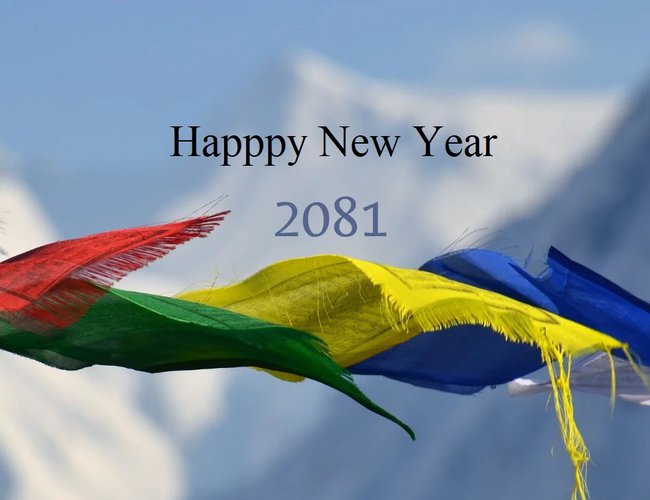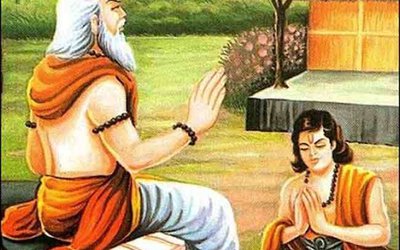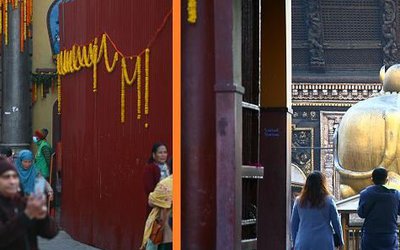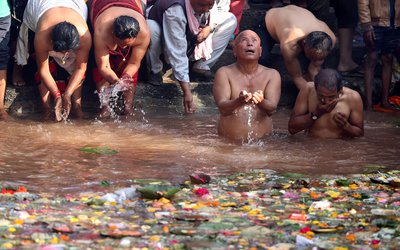
President Ram Chandra Paudel and Prime Minister Pushpka Kamal Dahal Prachanda extended New Year 2018 B.S greetings to Nepalese people. Today is national holiday. People across Nepal celebrate New Year or Baisakh 1 visiting temple and taking dip in different rivers. Along with Nepal, many states in India follow the Vikram Sambat Calendar and celebrate as new year.
The Vikram Samvat is called Bikram Sambat in Nepal. It is also known as the Vikrami calendar is a Hindu calendar historically used in the Indian subcontinent and still used in several states. It is a solar calendar, using twelve to thirteen lunar months each solar sidereal years. The year count of the Vikram Samvat calendar is usually 57 years ahead of the Gregorian calendar, except during January to April, when it is ahead by 56 years writes Wikipedia.
Ideally, Nepal is living 57 years (56 years and 4 months) ahead of the world, as it follows the Bikram Sambat calendar system. This unique time disjunction gives rise to a fascinating cultural phenomenon, the Nepali New Year, locally known as "Nava Barsha". Unlike the globally recognized Gregorian calendar, which marks the beginning of a new year on January 1st, Nepalese New Year typically falls in April, usually around the 13th or 14th day of the month.
Origin and History of Nepalese New Year
The Nepali New Year, also known as "Nava Varsha" has its origins deeply rooted in ancient history, intertwined with the cultural and religious heritage of Nepal. The first day of Baisakh month from Hindu Calendar System- the Bikaram Sambat or Bikram Era, marks the New Year in Nepal.
The mythological Vikramaditya, who governed the Indian subcontinent in antiquity, created the Bikram Sambat calendar. Based on historical mentions this calendar system had been initiated by Emperor Vikramaditya somewhere in the first century BCE, however the exact date remains unknown. This calendar system is roughly 56 years and 7 months ahead of the widely used solar Gregorian calendar in the West, known as BCE (Before Common Era).
The origins of Bikram Sambat are shrouded in legend and mythology, with various myths attributing its establishment to different rulers and periods. However, it is widely accepted that Bikram Sambat was introduced to Nepal during the reign of King Vikramaditya, from whom the calendar system originates.
According to Wikipedia, a number of ancient and medieval inscriptions used the Vikram Samvat. Although it was reportedly named after the legendary king Vikramaditya, the term "Vikrama Samvat" does not appear in the historical record before the 9th century; the same calendar system is found with other names, such as Krita and Malava.[3] In colonial scholarship, the era was believed to be based on the commemoration of King Vikramaditya expelling the Sakas from Ujjain. However, later epigraphical evidence and scholarship suggest that this theory has no historical basis. During the 9th century, epigraphical artwork began using Vikram Samvat (suggesting that the Hindu calendar era in use became popular as Vikram Samvat); Buddhist and Jain epigraphy continued to use an era based on the Buddha or the Mahavira.
Bikram Sambat Calendar
The Nepali New Year falls on the first day of the month of Baisakh, which usually corresponds to mid-April in the Gregorian calendar. This timing holds both astronomical and agricultural significance, marking the onset of spring and the beginning of the harvest season in Nepal.
Historically, the celebration of Nepali New Year has been deeply ingrained in the social and religious foundation of Nepali society. It serves as a time for renewal, reflection, and celebration, symbolizing the transition from the old to the new and the hope for a prosperous year ahead.
Throughout history, Nepali New Year celebrations have evolved, incorporating elements from various cultural and religious traditions. Today, the festivities are marked by a blend of ancient rituals, colorful customs, and communal gatherings, showcasing the cultural diversity and unity of the Nepali people.
When is Nepali New Year Celebrated?
Nepali New Year, also known as "Nava Varsha" is typically celebrated on the first day of the month of Baisakh in the Bikram Sambat calendar. This corresponds to mid-April in the Gregorian calendar. The exact date may vary slightly each year due to differences in lunar and solar calendars, however, this year, the Nepali New Year 2081 falls on 13th April, 2024.
The celebration of Nepali New Year is not only limited to the calendar change but also includes various festivities and cultural events. One such event is the Biska Jatra, predominantly celebrated by the Newari community in Nepal. This vibrant festival, held in Bhaktapur city, seeks streets filled with revelers indulging in feasting, drinking, and participating in chariot pulling, embodying the spirit of communal joy and togetherness.
Moreover, the Nepalese government also grants public holiday during this time, allowing people to fully immerse themselves in the festivities and cultural rituals. This further emphasizes the importance and widespread observance of the New Year across the country.
Tug of War at Bhaktapur: Tug of War, known locally as "Dhauju" or "Dhime Bazar", is a spirited competition that symbolizes strength and unity. Teams from different communities engage in friendly yet fiercely competitive matches, pulling at opposite ends of a rope. This traditional game not only serves as a source of entertainment but also fosters camaraderie and teamwork among participants and spectators alike.
Sindoor Jatra in Thimi: Sindoor Jatra, also known as the "Vermilion Powder Festival," is an integral part of the Nepali New Year celebrations, particularly in Bhaktapur. During this vibrant procession, locals clad in traditional attire carry palanquins adorned with the deity of Lord Bhairab. They traverse through the streets, spreading joy and tossing vermilion powder (sindoor) into the air, symbolizing the triumph of good over evil and the arrival of prosperity and happiness in the new year.
Sindoor Jatra in Thimi
Lingdo Pulling: Lingdo Pulling is a unique tradition observed primarily in the Bhaktapur district during the Nepali New Year. In this exhilarating ritual, devotees gather to pull a massive wooden pole known as the "lingdo" or "yosin." The objective is to erect the lingdo vertically, signifying the triumph of life over death and the renewal of spiritual energy. This ancient practice underscores the significance of communal effort and the resilience of the human spirit.
Tongue Piercing: Tongue piercing, or "Bunge Dyo," is a daring ritual practiced by devotees, particularly in the Bhaktapur and Lalitpur districts, during the Nepali New Year festivities. Participants, often in a trance-like state, undergo the piercing of their tongues with sharp objects, such as skewers or metal rods. This act of self-sacrifice is believed to demonstrate devotion to the deities and cleanse the soul of impurities, ushering in blessings and prosperity for the new year. Despite its intense nature, tongue piercing is regarded as a deeply spiritual and transformative experience by those who partake in it.
Indulge in the flavors of Nepal during the New Year celebrations by sampling a variety of traditional delicacies. From savory dishes to sweet treats, Nepal offers a culinary experience for your unique taste buds. Here are some must-try delicacies during the Nepali New Year:
- The Sentiment Of Monetary Policy Seems Focused On Increasing Eemand: FNCCI President Chandra Prasad Dhakal
- Jul 26, 2024
- Monetary Policy 081/82 Is Making The Economy More Dynamic: Governor Adhikari
- Jul 26, 2024
- Global IME Bank And Shashila Motors Signed Agreement Regarding Electric Vehicle loan
- Jul 26, 2024
- Lok Bahadur Thapa, permanent representative of the UN in New York, was appointed as the Vice President of ECOSOC
- Jul 26, 2024
- Leeladevi Gadtaula Became The First woman Chief Secretary
- Jul 26, 2024
















